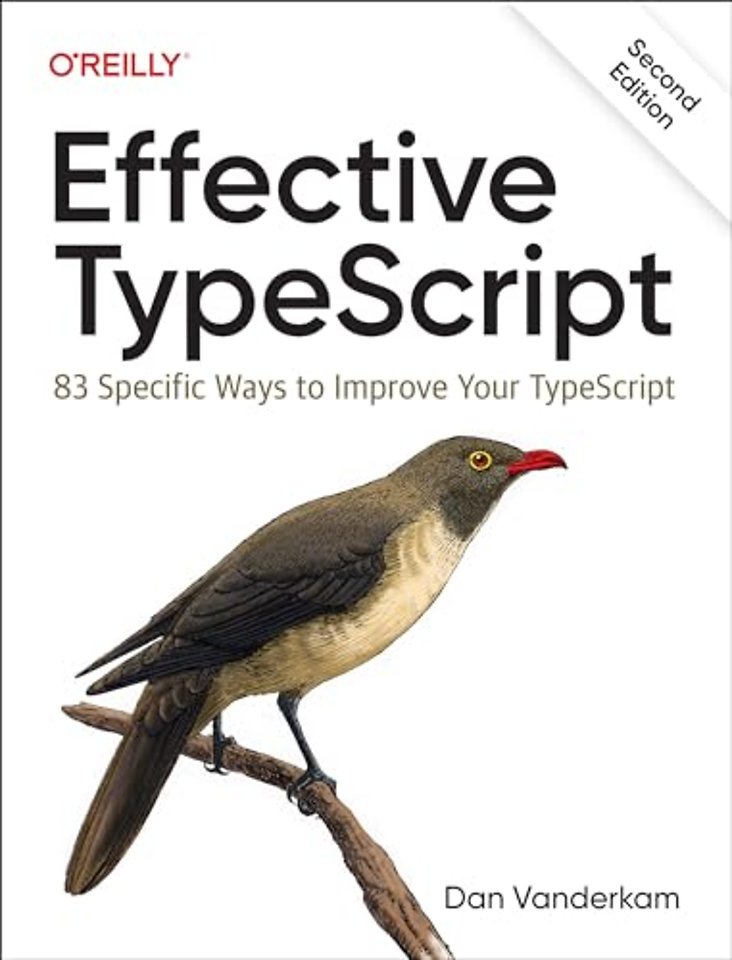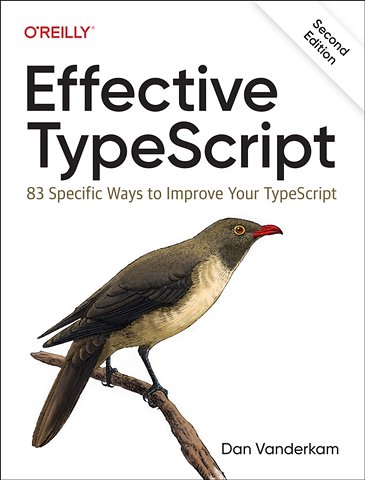Effective TypeScript
83 Specific Ways to Improve Your Typescript
Paperback Engels 2024 2e druk 9781098155063Samenvatting
TypeScript is a typed superset of JavaScript with the potential to solve many of the headaches for which JavaScript is famous. But TypeScript has a learning curve of its own, and understanding how to use it effectively takes time and practice. Using the format popularized by Effective C++ and Effective Java (both Addison-Wesley), this practical book features 83 items that give specific advice on what to do and what not to do, and how to think about the language.
Author Dan Vanderkam shows you how to apply each item's advice through concrete examples. This book will help you advance from a beginning or intermediate user familiar with TypeScript basics to an expert who knows how to use the language well.
Updated for TypeScript 5, this second edition includes two new chapters on type-level programming and TypeScript recipes.
- Learn the nuts and bolts of TypeScript's type system
- Use type inference to get full safety with a minimum of type annotations
- Design types to make your code safer and more understandable
- Model complex APIs using generic types and type-level programming
- Understand how dependencies and type declaration files work in TypeScript
- Successfully migrate your JavaScript code base to TypeScript
Specificaties
Lezersrecensies
Inhoudsopgave
Who This Book Is For
Why I Wrote This Book
How This Book Is Organized
Conventions in TypeScript Code Samples
Typographical Conventions Used in This Book
Using Code Examples
O’Reilly Online Learning
How to Contact Us
Acknowledgments
Preface to the First Edition (2019)
Acknowledgments to the First Edition
1. Getting to Know TypeScript
Item 1: Understand the Relationship Between TypeScript and JavaScript
Item 2: Know Which TypeScript Options You’re Using
Item 3: Understand That Code Generation Is Independent of Types
Item 4: Get Comfortable with Structural Typing
Item 5: Limit Use of the any Type
2. TypeScript’s Type System
Item 6: Use Your Editor to Interrogate and Explore the Type System
Item 7: Think of Types as Sets of Values
Item 8: Know How to Tell Whether a Symbol Is in the Type Space or Value Space
Item 9: Prefer Type Annotations to Type Assertions
Item 10: Avoid Object Wrapper Types (String, Number, Boolean, Symbol, BigInt)
Item 11: Distinguish Excess Property Checking from Type Checking
Item 12: Apply Types to Entire Function Expressions When Possible
Item 13: Know the Differences Between type and interface
Item 14: Use readonly to Avoid Errors Associated with Mutation
Item 15: Use Type Operations and Generic Types to Avoid Repeating Yourself
Item 16: Prefer More Precise Alternatives to Index Signatures
Item 17: Avoid Numeric Index Signatures
3. Type Inference and Control Flow Analysis
Item 18: Avoid Cluttering Your Code with Inferable Types
Item 19: Use Different Variables for Different Types
Item 20: Understand How a Variable Gets Its Type
Item 21: Create Objects All at Once
Item 22: Understand Type Narrowing
Item 23: Be Consistent in Your Use of Aliases
Item 24: Understand How Context Is Used in Type Inference
Item 25: Understand Evolving Types
Item 26: Use Functional Constructs and Libraries to Help Types Flow
Item 27: Use async Functions Instead of Callbacks to Improve Type Flow
Item 28: Use Classes and Currying to Create New Inference Sites
4. Type Design
Item 29: Prefer Types That Always Represent Valid States
Item 30: Be Liberal in What You Accept and Strict in What You Produce
Item 31: Don’t Repeat Type Information in Documentation
Item 32: Avoid Including null or undefined in Type Aliases
Item 33: Push Null Values to the Perimeter of Your Types
Item 34: Prefer Unions of Interfaces to Interfaces with Unions
Item 35: Prefer More Precise Alternatives to String Types
Item 36: Use a Distinct Type for Special Values
Item 37: Limit the Use of Optional Properties
Item 38: Avoid Repeated Parameters of the Same Type
Item 39: Prefer Unifying Types to Modeling Differences
Item 40: Prefer Imprecise Types to Inaccurate Types
Item 41: Name Types Using the Language of Your Problem Domain
Item 42: Avoid Types Based on Anecdotal Data
5. Unsoundness and the any Type
Item 43: Use the Narrowest Possible Scope for any Types
Item 44: Prefer More Precise Variants of any to Plain any
Item 45: Hide Unsafe Type Assertions in Well-Typed Functions
Item 46: Use unknown Instead of any for Values with an Unknown Type
Item 47: Prefer Type-Safe Approaches to Monkey Patching
Item 48: Avoid Soundness Traps
Item 49: Track Your Type Coverage to Prevent Regressions in Type Safety
6. Generics and Type-Level Programming
Item 50: Think of Generics as Functions Between Types
Item 51: Avoid Unnecessary Type Parameters
Item 52: Prefer Conditional Types to Overload Signatures
Item 53: Know How to Control the Distribution of Unions over Conditional Types
Item 54: Use Template Literal Types to Model DSLs and Relationships Between Strings
Item 55: Write Tests for Your Types
Item 56: Pay Attention to How Types Display
Item 57: Prefer Tail-Recursive Generic Types
Item 58: Consider Codegen as an Alternative to Complex Types
7. TypeScript Recipes
Item 59: Use Never Types to Perform Exhaustiveness Checking
Item 60: Know How to Iterate Over Objects
Item 61: Use Record Types to Keep Values in Sync
Item 62: Use Rest Parameters and Tuple Types to Model Variadic Functions
Item 63: Use Optional Never Properties to Model Exclusive Or
Item 64: Consider Brands for Nominal Typing
8. Type Declarations and @types
Item 65: Put TypeScript and @types in devDependencies
Item 66: Understand the Three Versions Involved in Type Declarations
Item 67: Export All Types That Appear in Public APIs
Item 68: Use TSDoc for API Comments
Item 69: Provide a Type for this in Callbacks if It’s Part of Their API
Item 70: Mirror Types to Sever Dependencies
Item 71: Use Module Augmentation to Improve Types
9. Writing and Running Your Code
Item 72: Prefer ECMAScript Features to TypeScript Features
Item 73: Use Source Maps to Debug TypeScript
Item 74: Know How to Reconstruct Types at Runtime
Item 75: Understand the DOM Hierarchy
Item 76: Create an Accurate Model of Your Environment
Item 77: Understand the Relationship Between Type Checking and Unit Testing
Item 78: Pay Attention to Compiler Performance
10. Modernization and Migration
Item 79: Write Modern JavaScript
Item 80: Use @ts-check and JSDoc to Experiment with TypeScript
Item 81: Use allowJs to Mix TypeScript and JavaScript
Item 82: Convert Module by Module Up Your Dependency Graph
Item 83: Don’t Consider Migration Complete Until You Enable noImplicitAny
Appendix. Item Mapping Between First and Second Editions
Index
About the Author
Anderen die dit boek kochten, kochten ook
Rubrieken
- advisering
- algemeen management
- coaching en trainen
- communicatie en media
- economie
- financieel management
- inkoop en logistiek
- internet en social media
- it-management / ict
- juridisch
- leiderschap
- marketing
- mens en maatschappij
- non-profit
- ondernemen
- organisatiekunde
- personal finance
- personeelsmanagement
- persoonlijke effectiviteit
- projectmanagement
- psychologie
- reclame en verkoop
- strategisch management
- verandermanagement
- werk en loopbaan







